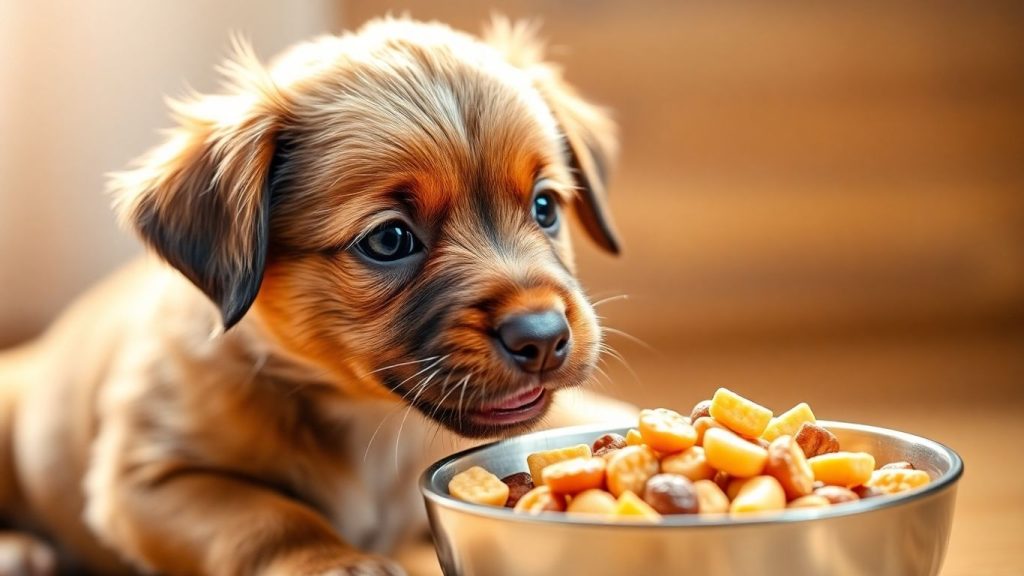Bringing a new puppy home is exciting! But choosing the right food can feel a bit overwhelming. You want the best for your growing furry friend, and that means picking food that supports their development. This article will help you understand the different types of food available, so you can make an informed choice. We'll look at the 4 healthy puppy food options that are out there.
Key Takeaways
- Kibble is a popular choice for its convenience and shelf life.
- Wet food can be more palatable and hydrating for puppies.
- Raw diets require careful planning to ensure nutritional balance.
- Freeze-dried food offers the benefits of raw with added convenience.
- Always consult your veterinarian when selecting a puppy food.
1. Kibble Choices
When you're picking out food for your new puppy, kibble is a super common and convenient choice. It's like the everyday staple for many dog owners, and for good reason! It's easy to store, has a good shelf life, and can be really budget-friendly. Plus, the variety out there is pretty amazing, so you can find something that fits your pup's specific needs.
The key is to look for a high-quality kibble that's specifically formulated for puppies. This means it'll have the right balance of protein, fats, vitamins, and minerals to support their rapid growth and development. Think of it as building a strong foundation for their whole life!
Here are a few things to keep an eye out for when you're browsing the aisles:
- Protein Source: Look for a named meat source like chicken, lamb, or fish as the first ingredient. This is what your growing pup needs to build strong muscles.
- Healthy Fats: Ingredients like fish oil or flaxseed provide omega-3 and omega-6 fatty acids, which are great for their skin and coat – you know, that super soft puppy fur!
- Carbohydrates: Whole grains like brown rice or oats are good sources of energy. Some puppies do better with grain-free options, so it's worth chatting with your vet if you're unsure.
- No Fillers: Try to avoid kibble with a lot of artificial colors, flavors, or preservatives. You want the good stuff, not just empty calories.
Choosing the right kibble might seem like a big decision, but it's all about finding a food that makes your puppy happy and healthy. Don't be afraid to try a few different brands or formulas until you find the perfect match. Your vet is also a fantastic resource for personalized recommendations based on your puppy's breed and individual needs.
2. Wet Food Options
Wet food can be a fantastic choice for puppies, and it's often a hit with picky eaters! It's got a higher moisture content than kibble, which is great for keeping your pup hydrated. Plus, the texture is usually softer, making it easier for those little puppy teeth to manage. Many owners find that wet food really helps their puppies transition to solid food.
When you're looking at wet food options, keep a few things in mind:
- Ingredient Quality: Always check the ingredient list. You want to see real meat as the first ingredient, not fillers or by-products. This ensures your puppy is getting the protein they need to grow strong.
- Nutritional Balance: Make sure the food is specifically formulated for puppies. Growing pups have different nutritional needs than adult dogs, so look for labels that confirm it meets AAFCO standards for growth.
- Variety: Don't be afraid to try a few different brands or flavors to see what your puppy enjoys most. Just introduce new foods gradually to avoid upsetting their tummy.
Wet food can be a bit more expensive than kibble, and it doesn't offer the same dental benefits that crunchy kibble can. However, for many puppies, the palatability and hydration benefits make it a really worthwhile option to consider for their early development.
3. Raw Diet Considerations
Thinking about a raw diet for your puppy? It's definitely a popular choice for many pet parents, and for good reason! Raw diets aim to mimic what dogs might eat in the wild, typically including raw meat, bones, organs, and sometimes fruits and vegetables. The idea is that this more natural way of eating can lead to a shinier coat, better digestion, and more energy for your pup.
It's super important to get the balance right, though. Puppies have specific nutritional needs as they grow, and a poorly planned raw diet can lead to deficiencies or imbalances. If you're leaning towards raw, here are a few things to keep in mind:
- Consult your vet or a canine nutritionist: This is probably the most important step. They can help you create a balanced diet plan tailored to your puppy's age, breed, and activity level. They can also advise on safe food handling practices.
- Source quality ingredients: Look for reputable suppliers for your raw meats and organs. Freshness and proper handling are key to preventing foodborne illnesses for both you and your puppy.
- Understand the risks: While many people have success with raw diets, there are potential risks like bacterial contamination (Salmonella, E. coli) and the danger of choking or internal damage from bones if not prepared correctly. Always supervise your puppy when they're eating raw bones.
- Transition slowly: If you decide to switch to a raw diet, do it gradually. Mixing a small amount of raw food with their current food and slowly increasing the raw portion over a week or two can help prevent tummy upset.
A well-researched and carefully prepared raw diet can be a fantastic option for your growing puppy, offering a wealth of natural nutrients. Just remember that diligence and expert advice are your best friends in making this a healthy and safe choice for your furry friend.
4. Freeze-Dried Food Benefits
Freeze-dried puppy food is a pretty neat option for your growing pup. It's made by taking high-quality ingredients, freezing them, and then removing the water in a special way. This process keeps most of the good stuff, like vitamins and minerals, locked in. Plus, it makes the food super lightweight and easy to store, which is a win-win.
What's really cool about freeze-dried food is how it can be rehydrated. You just add water, and it turns back into a moist, tasty meal that dogs seem to love. It’s a great way to give them something that’s closer to a fresh meal without all the hassle of preparing it yourself.
Here are some of the perks:
- Preserves nutrients: The freeze-drying method is excellent at keeping the natural goodness of the ingredients intact. This means your puppy gets a really nutrient-dense meal.
- Long shelf life: Because the water is removed, freeze-dried food can sit in your pantry for a long time without going bad, which is super convenient.
- Lightweight and portable: Perfect for travel or if you're just heading to the park. It’s much easier to carry around than heavy bags of kibble or cans of wet food.
- Palatability: Many dogs find the texture and taste of rehydrated freeze-dried food really appealing, which can be a big help if you have a picky eater.
Think of it as a way to give your puppy a really wholesome meal that’s also incredibly convenient for you. It’s a fantastic middle ground between traditional kibble and more involved raw or fresh food diets.
Happy Puppy, Happy Life!
So, there you have it! Picking the right food for your growing pup can feel like a big deal, but it doesn't have to be overwhelming. We've looked at some great options that will give your furry friend the best start. Remember, a healthy diet is just one piece of the puzzle. Lots of love, playtime, and maybe a few extra belly rubs will go a long way too. Here's to many happy, healthy years with your amazing companion!
Frequently Asked Questions
What are the main types of puppy food available?
Puppies can eat kibble, wet food, raw food, or freeze-dried food. Each has its own benefits, and the best choice depends on your puppy's needs and your preferences.
How do I know if a kibble is good for my puppy?
Look for high-quality protein sources like chicken or lamb as the first ingredient. Also, make sure it's specifically formulated for puppies, as they have different nutritional needs than adult dogs.
Is wet food a good option for puppies?
Yes, wet food can be a great choice. It's often more palatable and has higher moisture content, which is good for hydration. Just be sure it's a complete and balanced meal for growing puppies.
What should I consider if I want to feed my puppy a raw diet?
A raw diet usually includes raw meat, bones, and organs. It's important to balance the nutrients carefully to ensure your puppy gets everything they need. Consulting with a vet or a pet nutritionist is highly recommended before starting a raw diet.
What are the advantages of freeze-dried puppy food?
Freeze-dried food keeps many of the nutrients from the raw ingredients. It's lightweight, has a long shelf life, and can be rehydrated with water, making it a convenient option that's close to a raw diet.
How much should I feed my growing puppy?
The amount to feed depends on the puppy's age, breed, activity level, and the specific food you choose. Always check the feeding guidelines on the food packaging and adjust as needed, or ask your veterinarian for advice.



